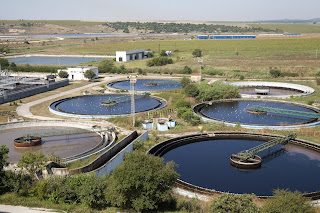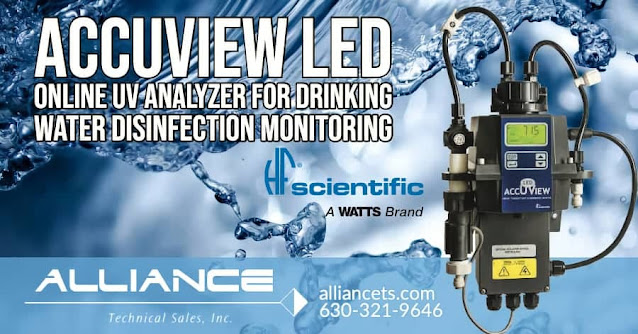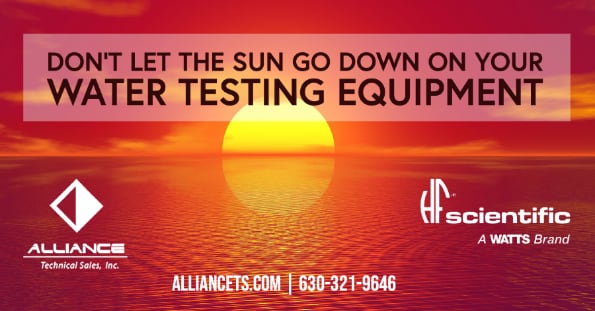An informative and educational resource specializing in process control instrumentation, analytical instruments, and related industrial equipment. Content includes technology basics, how-to's, new product developments, and application notes. Blog is courtesy of Alliance Technical Sales, a leading Manufacturers' Rep headquartered in Clarendon Hills, IL and serving customers in Illinois, Indiana, Iowa, Michigan and Wisconsin.
HF scientific Instrumentation, Test Kits and Chemical Reagents Used for Municipal Water Monitoring
The AccUView LED Online UV Analyzer for Drinking Water Disinfection Monitoring
With over 30 years of optical design expertise HF scientific has developed an AccUView LED Online UV Analyzer specifically for drinking water disinfection monitoring. Engineered using leading edge microprocessor technology, the AccUView LED is the most reliable and cost efficient instrument for monitoring the % Transmission and Absorbance of a UV Disinfection System for drinking water. Standard features include simple calibration procedures, a bubble rejection system, an Ultrasonic Autoclean System designed to reduce operator maintenance time, and selectable scaling of % Transmission or Absorbance.
STANDARD FEATURES
- UVC LED light source - Longer life and mercury free
- Two measurement scales - % Transmission and Absorbance
- Standard communications include 4-20 mA with isolator or RS-485 with Modbus protocol.
- Modular microprocessor based technology ensures high quality at an affordable price.
- HF scientific certified 100%T Calibration Standard.
- Simple Modular Design.
- Ultrasonic autoclean system reduces time consuming maintenance
For more information, contact:
Alliance Technical Sales
630-321-9646
Don't Let the Sun Go Down on Your Water Testing Instrumentation
Frustrated with Water Quality Instrumentation "Sunsetting"?
HF scientific is committed to supporting rural and suburban water markets. Other water quality instrument suppliers abandon these markets and favor large urban water systems. They then push lucrative service contracts to support their product's complex operating scheme. That's not the HF way. HF scientific will gladly provide in-depth product training, both remotely or in person, and their products are cost-effective and easy to use. That's particularly important for water systems that don't have dedicated instrument personnel or where one operator wears many hats.
HF scientific's value proposition embraces all customers who want to maintain their equipment simply, affordably and for the long term.
Sunsets are beautiful, except when its the sunsetting of your valuable water testing equipment.
Alliance Technical Sales
630-321-9646
Turbidity Measurement Tailored for Water Treatment Applications
Learn about the HF Scientific MTOL+ turbidimeter from this short video. Turbidity measurement is a common task in water treatment and water quality monitoring. Instruments designed for accuracy and easy of use, such as the MTOL+, can save time while producing reliable results. Notable features of the redesigned online instrument include:
- Primary calibration can be completed in less than 5 minutes.
- Low volume sample chamber enables quick response time.
- Field replaceable long lasting light source.
- Simple modular design with low maintenance burden
- No external controller needed.
- Bubble rejection system eliminates bubbles without delaying response time.
- Data logging and storage of 1 year’s measurement and calibration data
- Variable user-selectable logging interval from 1 to 60 minutes
- Download data via USB
- Software updates via USB
- Isolated 4-20mA output standard
- 4-20mA and RS-485 Modbus outputs simultaneously
- Ultrasonic cleaning standard
Process Analytics Product Guide
 |
| Ingold and Thornton brands provide wide ranging solutions for process analytic challenges. Image courtesy Mettler Toledo |
The full range of the company's Ingold and Thornton brand capabilities and applications for liquid, gas, and pure water analytics is illustrated in a newly available brochure. The document is useful as an overview of all potential intersections of your own work and the products and capabilities of Mettler Toledo.
Request a full copy of the brochure from a fluid analytics specialist. Share your measurement and analytical challenges with experienced professionals, leveraging your own process knowledge and experience with their product application expertise to develop effective solutions.
TOC Measurement in Water Systems
 |
| TOC analyzer for continuous on-line measurement Image courtesy Mettler Toledo Thornton |
The measurement technology involves oxidation of carbon compounds in the presence of UV light and measuring sample conductivity. Processing of the raw measurement yields a value for TOC. Analytical instruments benefit from having features and attributes that lessen the need for human involvement and deliver rapid and accurate results. Mettler Toledo provides an advanced solution for TOC measurement with it 5000TOCi analyzer.
- Fast continuous measurement
- Reagent and chemical free
- Reliable operation
- ISM Intelligent Sensor Management
Water Quality Testing - Turbidity Standards
 |
| ProCal turbidity standards are suitable for use with instruments from other manufacturers. Image Courtesy HF Scientific |
Calibration requires the use of a prepared sample of a known value. HF Scientific, manufacturer of water quality instrumentation, reagents, and standards, provides high quality premixed turbidity standards that are suitable for use with their instruments, as well as those of several other manufacturers.
Share your water quality analysis requirements and challenges with process analytic specialists, combining your own experience and knowledge with their product application expertise to develop effective solutions.
Water Quality Analysis – Constituent Survey Part 3
 |
| Industrial steam turbines can be negatively impacted by silica |
To conclude the three part series on water quality analysis in process control related industrial applications we examine silica, another element which in sufficient quantities can become a confounding variable in water for industrial use. In natural settings, silica, or silicon dioxide, is a plentiful compound. Its presence in water provides a basis for some corrosion-inhibiting products, as well as conditioners and detergents. Problems arise, however, when high concentrates of silica complicate industrial processes which are not designed to accommodate elevated levels. Specifically, silica is capable of disrupting processes related to boilers and turbines. In environments involving high temperature, elevated pressure, or both, silica can form crystalline deposits on machinery surfaces. This inhibits the operation of turbines and also interferes with heat transfer. These deposits can result in many complications, ranging through process disruption, decreased efficiency, and resources being expended for repairs.
While silica and the other compounds mentioned in this series are naturally occurring, the support systems in place to expertly control the quality of water is the most basic requirement for harvesting one of the earth’s most precious resources for use. As a matter of fact, the identification and control of compounds in water – both entering the industrial process and exiting the industrial process – demonstrates key tenets of process control fundamentals: precision, accuracy, durability, and technological excellence paired with ingenuity to create the best outcome not just one time, but each time.
The measurement of the various contaminating constituents of process water requires special equipment and techniques. Share your water quality measurement requirements and challenges with fluid process specialists, combining your own knowledge and experience with their product application expertise to develop effective solutions.
Water Quality Analysis – Constituent Survey (Part 2)
 |
| Sewage treatment is but one area where water quality measurement is employed |
Continuing the examination of water quality monitoring in municipal and industrial processes, another key variable which requires monitoring for industrial water use is sulfate. Sulfate is a combination of sulfur and oxygen, salts of sulfuric acid. Similarly to chlorides, they can impact water utilization processes due to their capability for corrosion. The power generation industry is particularly attuned to the role of sulfates in their steam cycle, as should be any boiler operator. Minerals can concentrate in steam drums and accelerate corrosion. Thanks to advancements in monitoring technology, instruments are available which monitor for both chlorides (covered in the previous installment in this series) and sulfates with minimal supervision needed by the operator, ensuring accurate detection of constituent levels outside of an acceptable range. Ionic separation technologies precisely appraise the amount of sulfate ions in the stream, allowing for continuous evaluation and for corrective action to be taken early-on, avoiding expensive repairs and downtime.
Another substance worthy of measurement and monitoring in process water is sodium. Pure water production equipment, specifically cation exchange units, can be performance monitored with an online sodium analyzer. Output from the cation bed containing sodium, an indication of deteriorating performance, can be diverted and the bed regenerated. Steam production and power generation operations also benefit from sodium monitoring in an effort to combat corrosion in turbines, steam tubes, and other components. Sodium analyzers are very sensitive, able to detect trace levels.
Ammonia is comprised of nitrogen and hydrogen and, while colorless, carries a distinct odor. Industries such as agriculture utilize ammonia for fertilizing purposes, and many other specializations, including food processing, chemical synthesis, and metal finishing, utilize ammonia for their procedural and product-oriented needs. An essential understanding of ammonia, however, includes the fact that the chemical is deadly to many forms of aquatic life. Removing ammonia from industrial wastewater is a processing burden of many industries due to the environmental toxicity.
Methods for removing ammonia from wastewater include a biological treatment method called ‘conventional activated sludge’, aeration, sequencing batch reactor, and ion exchange. Several methods exist for in-line or sample based measurement of ammonia concentration in water. Each has particular procedures, dependencies, and limitations which must be considered for each application in order to put the most useful measurement method into operation.
As water is an essential part of almost every facet of human endeavor and the environment in which we all dwell, the study and application of related analytics is an important component of many water based processes. The variety of compounds which can be considered contaminants or harmful elements when dissolved or contained in water presents multiple challenges for engineers and process operators.
Alliance Technical Sales specializes in the instruments, equipment, and supplies utilized to analyze water and other liquids employed throughout commercial and industrial operations.
Water Quality Analysis – Constituent Survey (Part 1)
 |
| Many industrial and commercial processes rely on specific water quality requirements |
In order to use water properly, industrial professionals combine state of the art analyzers with technical expertise to evaluate water quality for use or disposal. Two essential values of process control are ensuring elements of a control system are accurate and secure, and, furthermore, that they are accurate and secure for each product every time. By properly vetting water in industry, engineers and other personnel in fields such as pharmaceuticals, chemical, food & beverage, brewing, power, and microelectronics are able to maintain standards of production excellence and conform with regulatory requirements related to water quality.
The amount of dissolved oxygen present in water can correlate with the degree of movement at an air-water interface, also being impacted by pressure, temperature, and salinity. Excessive or deficient dissolved oxygen levels in industrial process waters may have an impact on process performance or end product quality. Likely, the most common application for dissolved oxygen measurement is in the evaluation of wastewater for biological oxygen demand. The primary function of dissolved oxygen in wastewater is to enable and enhance the oxidation of organic material by aerobic bacteria, a necessary step in treatment.
To measure dissolved oxygen, specialized sensors and companion instruments are employed that require careful maintenance and trained technical operators. The level of measurement precision varies depending on the industry employing the technology, with numerous applications also being found in the food & beverage and pharmaceutical industries. In-line continuous measurement is used in wastewater processing to determine if the dissolved oxygen remains in a range that supports the bacteria necessary for biodegradation.
There are other constituents of what we refer to as “water” that are subject to measurement and monitoring for a range of institutional, industrial, and municipal applications. Those will be explored in the next part of this article series.
The measurement of dissolved oxygen or chloride concentration requires special equipment and techniques. Share your water quality measurement requirements and challenges with fluid process specialists, combining your own knowledge and experience with their product application expertise to develop effective solutions.
HF Scientific - Water Quality Measurement
New M300 Series Single and Multi-Variable Transmitters From Mettler Toledo
Mettler Toledo recently introduced a new line of transmitters to deliver maximum effectiveness from their array of water quality and process analytics sensors. The M300 is available in 1/2 DIN and 1/4 DIN sizes, with a single or dual channel configuration. Two versions are tailored for process analytics applications or water quality applications. Analog or digital ISM sensors for pH/ORP, conductivity, dissolved oxygen and ozone can be utilized with the new transmitter, which features intuitive operation and excellent ergonomics.
Learn more about the M300 transmitter and see it in action in the video. Reach out to a product specialist with your water and process analytical challenges, combining your process knowledge with their product application expertise to develop effective solutions.

